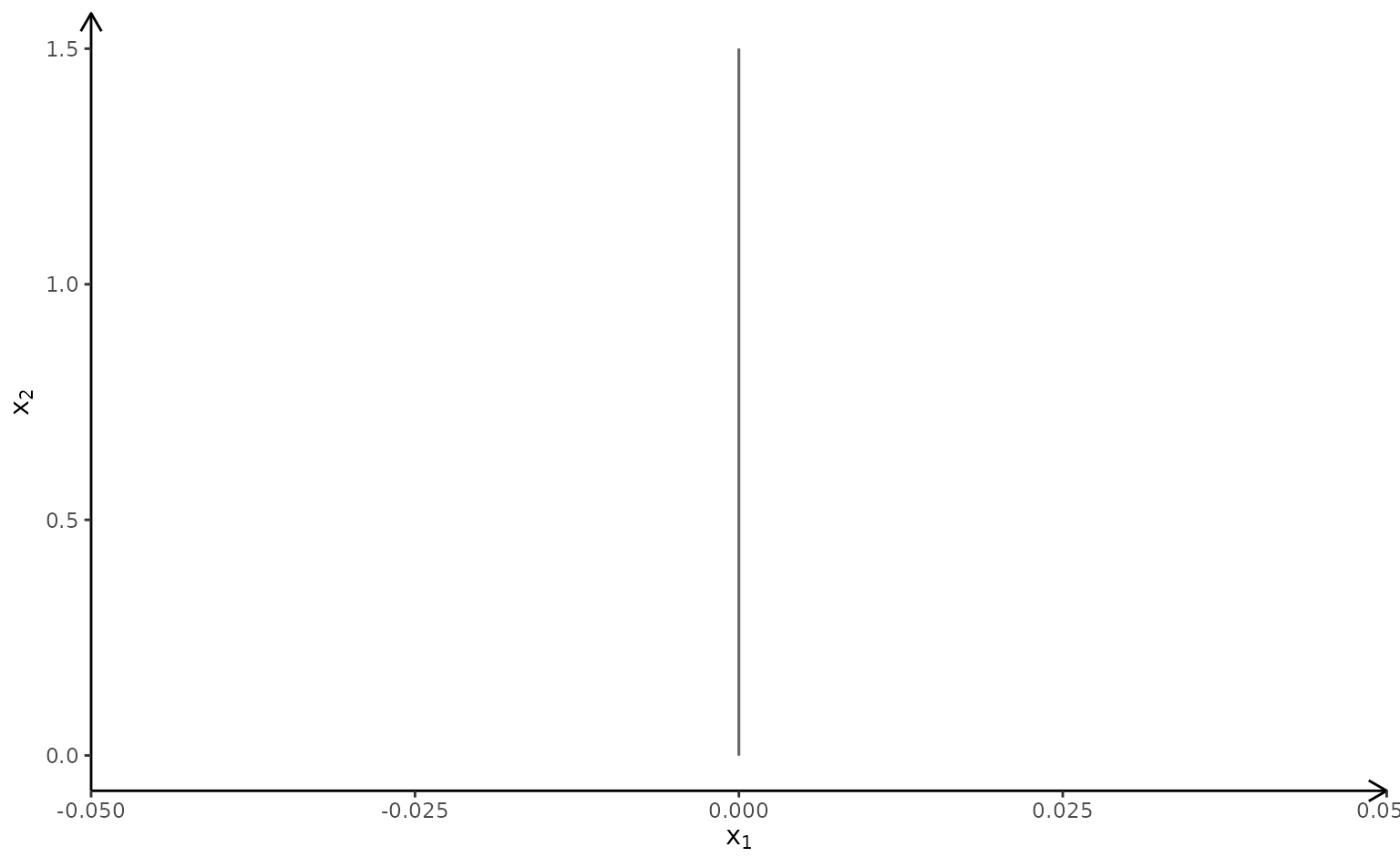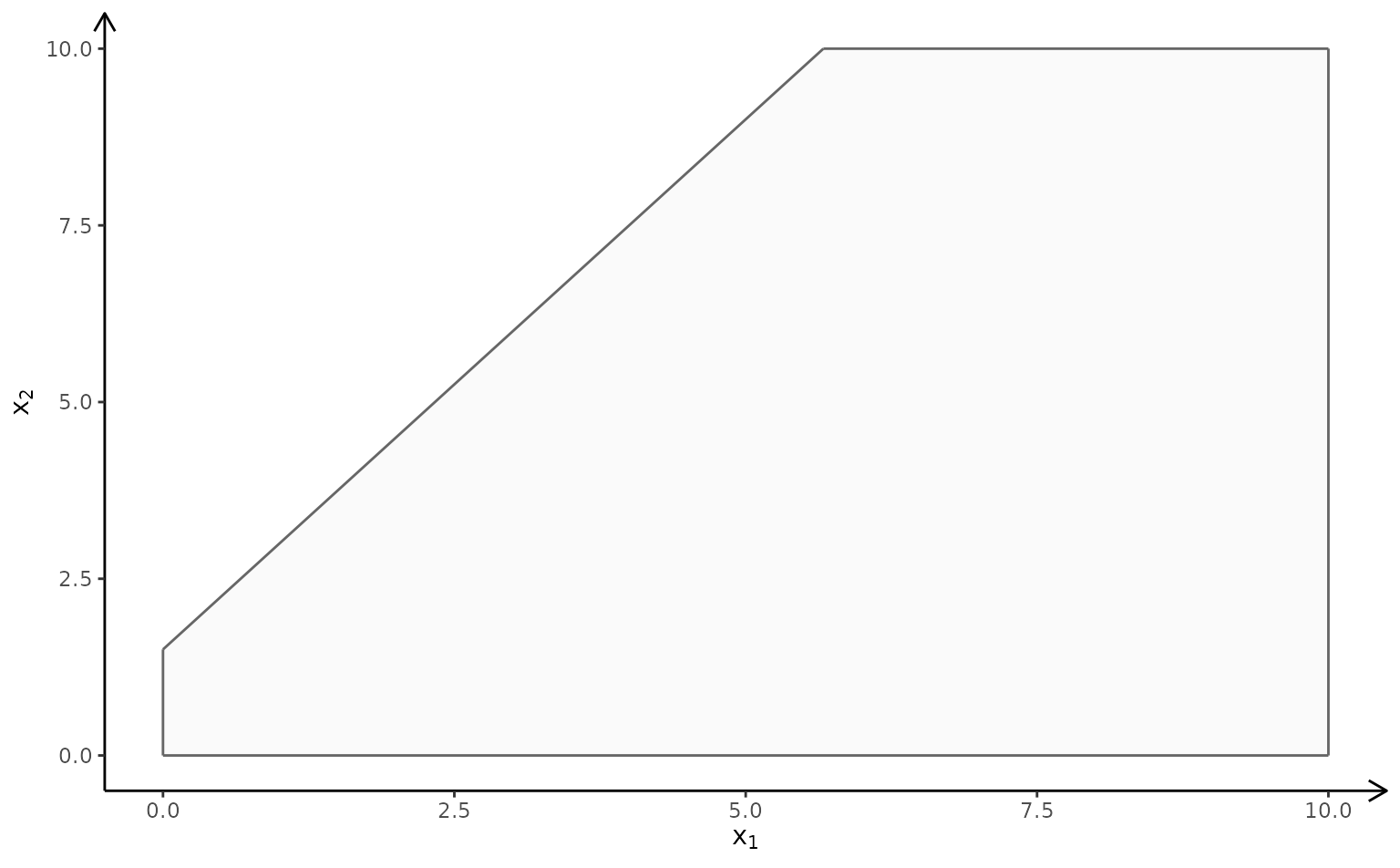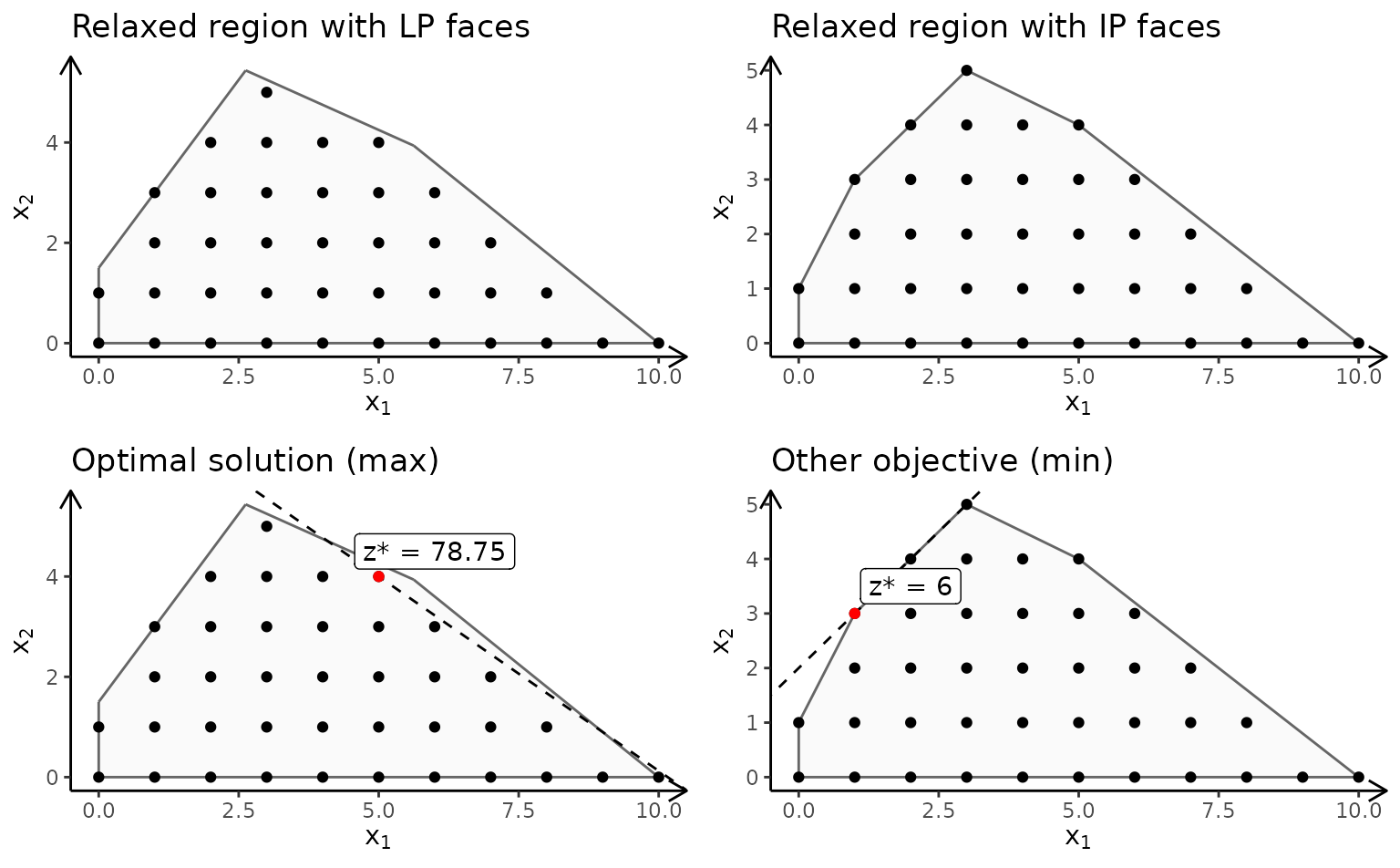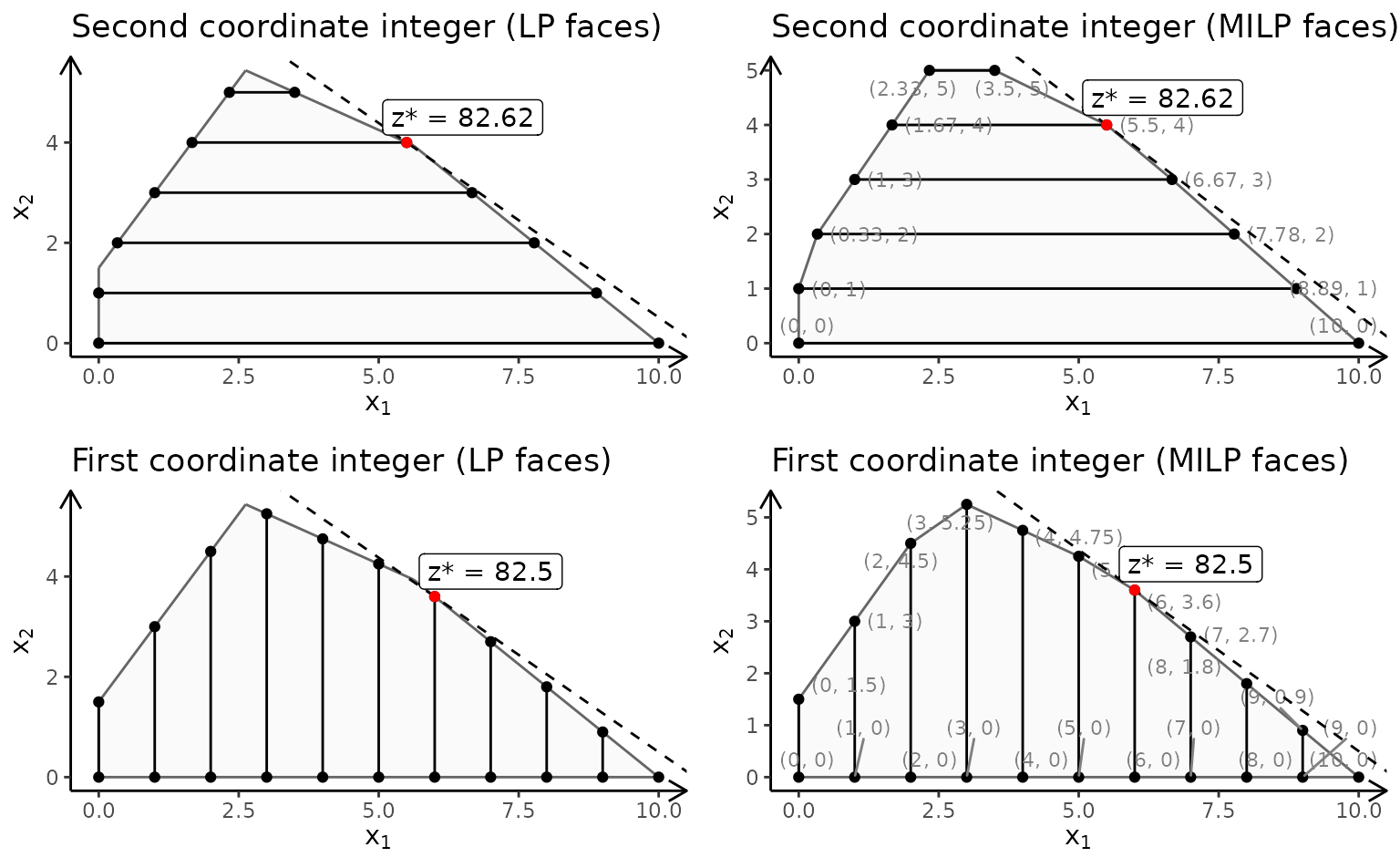With gMOIP you can make 2D plots of the the
polytope/feasible region/solution space of a linear programming (LP),
integer linear programming (ILP) model, or mixed integer linear
programming (MILP) model. This vignette gives examples on how to make
plots given a model with two variables.
First we load the package:
We define the model (could also be minimized) with 2 variables:
A <- matrix(c(-3,2,2,4,9,10), ncol = 2, byrow = TRUE)
b <- c(3,27,90)
obj <- c(7.75, 10) # coefficients cPlots are created using function plotPolytope which
outputs a ggplot2 object.
LP model
Let us consider different plots of the polytope of the LP model with non-negative variables ():
# The polytope with the corner points
p1 <- plotPolytope(
A,
b,
obj,
type = rep("c", ncol(A)),
crit = "max",
faces = rep("c", ncol(A)),
plotFaces = TRUE,
plotFeasible = TRUE,
plotOptimum = FALSE,
labels = NULL
) + ggplot2::ggtitle("Feasible region only")
p2 <- plotPolytope(
A,
b,
obj,
type = rep("c", ncol(A)),
crit = "max",
faces = rep("c", ncol(A)),
plotFaces = TRUE,
plotFeasible = TRUE,
plotOptimum = TRUE,
labels = "coord"
) + ggplot2::ggtitle("Solution LP max")
p3 <- plotPolytope(
A,
b,
obj,
type = rep("c", ncol(A)),
crit = "min",
faces = rep("c", ncol(A)),
plotFaces = TRUE,
plotFeasible = TRUE,
plotOptimum = TRUE,
labels = "n"
) + ggplot2::ggtitle("Solution LP min")
p4 <- plotPolytope(
A,
b,
obj,
type = rep("c", ncol(A)),
crit = "max",
faces = rep("c", ncol(A)),
plotFaces = TRUE,
plotFeasible = TRUE,
plotOptimum = TRUE,
labels = "coord"
) + ggplot2::xlab("x") + ggplot2::ylab("y") + ggplot2::ggtitle("Solution (max) with other axis labels")
gridExtra::grid.arrange(p1, p2, p3, p4, nrow = 2)
You may also consider a LP model with no non-negativity constraints:
A <- matrix(c(-3, 2, 2, 4, 9, 10, 1, -2), ncol = 2, byrow = TRUE)
b <- c(3, 27, 90, 2)
obj <- c(7.75, 10)
plotPolytope(
A,
b,
obj,
type = rep("c", ncol(A)),
nonneg = rep(FALSE, ncol(A)),
crit = "max",
faces = rep("c", ncol(A)),
plotFaces = TRUE,
plotFeasible = TRUE,
plotOptimum = FALSE,
labels = NULL
)
Note The package don’t plot feasible regions that are unbounded e.g if we drop the second and third constraint we get the wrong plot:
A <- matrix(c(-3,2), ncol = 2, byrow = TRUE)
b <- c(3)
obj <- c(7.75, 10)
# Wrong plot
plotPolytope(
A,
b,
obj,
type = rep("c", ncol(A)),
crit = "max",
faces = rep("c", ncol(A)),
plotFaces = TRUE,
plotFeasible = TRUE,
plotOptimum = FALSE,
labels = NULL
)
One solution is to add a bounding box and check if the bounding box is binding
A <- rbind(A, c(1,0), c(0,1))
b <- c(b, 10, 10)
plotPolytope(
A,
b,
obj,
type = rep("c", ncol(A)),
crit = "max",
faces = rep("c", ncol(A)),
plotFaces = TRUE,
plotFeasible = TRUE,
plotOptimum = FALSE,
labels = NULL
)
You may also use e.g lpsolve to check if the solution is
unbounded.
ILP model
If we add integer constraints to the model () you may view the feasible region different ways:
A <- matrix(c(-3,2,2,4,9,10), ncol = 2, byrow = TRUE)
b <- c(3,27,90)
obj <- c(7.75, 10)
p1 <- plotPolytope(
A,
b,
obj,
type = rep("i", ncol(A)),
crit = "max",
faces = rep("c", ncol(A)),
plotFaces = TRUE,
plotFeasible = TRUE,
plotOptimum = FALSE,
labels = "n"
) + ggplot2::ggtitle("Relaxed region with LP faces")
p2 <- plotPolytope(
A,
b,
obj,
type = rep("i", ncol(A)),
crit = "max",
faces = rep("i", ncol(A)),
plotFaces = TRUE,
plotFeasible = TRUE,
plotOptimum = FALSE,
labels = "n"
) + ggplot2::ggtitle("Relaxed region with IP faces")
p3 <- plotPolytope(
A,
b,
obj,
type = rep("i", ncol(A)),
crit = "max",
faces = rep("c", ncol(A)),
plotFaces = TRUE,
plotFeasible = TRUE,
plotOptimum = TRUE,
labels = "n"
) + ggplot2::ggtitle("Optimal solution (max)")
p4 <- plotPolytope(
A,
b,
obj = c(-3, 3),
type = rep("i", ncol(A)),
crit = "max",
faces = rep("i", ncol(A)),
plotFaces = TRUE,
plotFeasible = TRUE,
plotOptimum = TRUE,
labels = "n"
) + ggplot2::ggtitle("Other objective (min)")
gridExtra::grid.arrange(p1, p2, p3, p4, nrow = 2)
MILP model
Finally, let us have a look at a MILP model:
A <- matrix(c(-3,2,2,4,9,10), ncol = 2, byrow = TRUE)
b <- c(3,27,90)
obj <- c(7.75, 10)
p1 <- plotPolytope(
A,
b,
obj,
type = c("c", "i"),
crit = "max",
faces = c("c", "c"),
plotFaces = TRUE,
plotFeasible = TRUE,
plotOptimum = TRUE,
labels = "n"
) + ggplot2::ggtitle("Second coordinate integer (LP faces)")
p2 <- plotPolytope(
A,
b,
obj,
type = c("c", "i"),
crit = "max",
faces = c("c", "i"),
plotFaces = TRUE,
plotFeasible = TRUE,
plotOptimum = TRUE,
labels = "coord"
) + ggplot2::ggtitle("Second coordinate integer (MILP faces)")
p3 <- plotPolytope(
A,
b,
obj,
type = c("i", "c"),
crit = "max",
faces = c("c", "c"),
plotFaces = TRUE,
plotFeasible = TRUE,
plotOptimum = TRUE,
labels = "n"
) + ggplot2::ggtitle("First coordinate integer (LP faces)")
p4 <- plotPolytope(
A,
b,
obj,
type = c("i", "c"),
crit = "max",
faces = c("i", "c"),
plotFaces = TRUE,
plotFeasible = TRUE,
plotOptimum = TRUE,
labels = "coord"
) + ggplot2::ggtitle("First coordinate integer (MILP faces)")
gridExtra::grid.arrange(p1, p2, p3, p4, nrow = 2)
Saving plots to LaTeX
If you write a paper using LaTeX, you may create a TikZ file of the plot for LaTeX using
library(tikzDevice)
tikz(file = "plot_polytope.tex", standAlone=F, width = 7, height = 6)
plotPolytope(
A,
b,
obj,
type = rep("i", ncol(A)),
crit = "max",
faces = rep("c", ncol(A)),
plotFaces = TRUE,
plotFeasible = TRUE,
plotOptimum = TRUE,
labels = "n",
latex = TRUE
)
dev.off()